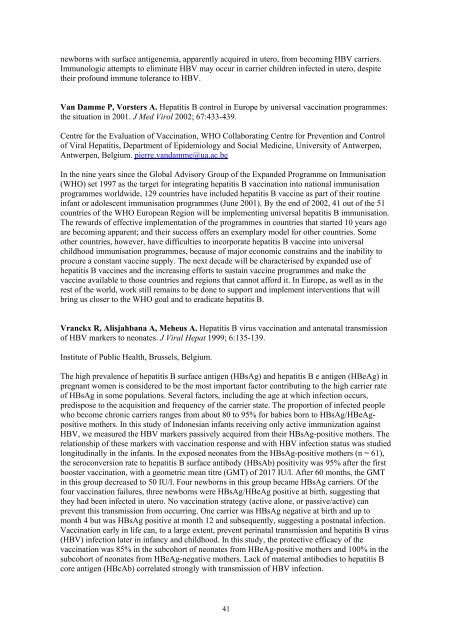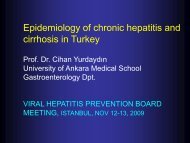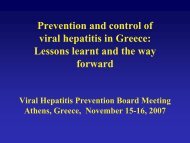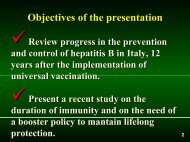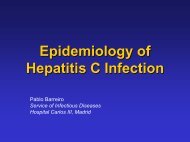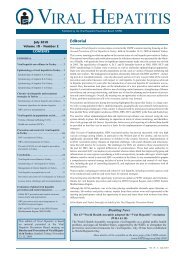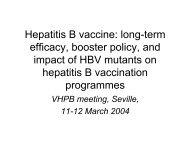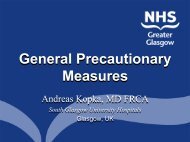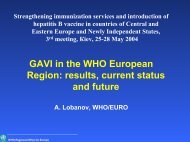demonstrated that the HBsAg rate reached the adult level before the fifth year <strong>of</strong> age, <strong>and</strong> neonatalvacc<strong>in</strong>ation with either plasma-derived or recomb<strong>in</strong>ant <strong>hepatitis</strong> B vacc<strong>in</strong>es provided a similar75% protective efficacy aga<strong>in</strong>st HBV <strong>in</strong>fection. The high rate <strong>of</strong> follow-up <strong>and</strong> blood testscoverage <strong>of</strong> the cohorts provided data to show 75% protection at the tenth to eleventh years <strong>of</strong> ageaga<strong>in</strong>st serum HBsAg <strong>and</strong> also aga<strong>in</strong>st prolonged hepatic dysfunction. The strategy <strong>of</strong> <strong>control</strong>l<strong>in</strong>g<strong>hepatitis</strong> B nationwide was based on the universal immunisation <strong>of</strong> newborns, beg<strong>in</strong>n<strong>in</strong>g <strong>in</strong> cities<strong>and</strong> then the rural areas. The large-scale vacc<strong>in</strong>e source was provided by domestic plants throughtechnology transfer, first provid<strong>in</strong>g plasma-derived vacc<strong>in</strong>e replaced completely by recomb<strong>in</strong>antDNA vacc<strong>in</strong>e <strong>in</strong> 1997. An <strong>of</strong>ficial survey <strong>in</strong> 1999 us<strong>in</strong>g a cluster sampl<strong>in</strong>g <strong>of</strong> 25,878 children from31 prov<strong>in</strong>ces reported an average coverage rate <strong>of</strong> three dose <strong>of</strong> <strong>hepatitis</strong> B vacc<strong>in</strong>ation <strong>of</strong> 70.7%,be<strong>in</strong>g higher <strong>in</strong> urban areas. The M<strong>in</strong>istry <strong>of</strong> Public Health <strong>of</strong> Ch<strong>in</strong>a has planned to <strong>in</strong>tegrate<strong>hepatitis</strong> B vacc<strong>in</strong>ation <strong>in</strong>to the nationwide EPI program with Government-provided vacc<strong>in</strong>esstart<strong>in</strong>g January 1, 2002.Sutanto A, Suarnawa IM, Nelson CM, Stewart T, Soewarso TI. Home delivery <strong>of</strong> heat-stablevacc<strong>in</strong>es <strong>in</strong> Indonesia: outreach immunization with a prefilled, s<strong>in</strong>gle-use <strong>in</strong>jection device. BullWorld Health Organ 1999; 77:119-126.Disease <strong>Prevention</strong> <strong>and</strong> Health Promotion, NTB Prov<strong>in</strong>ce, M<strong>in</strong>istry <strong>of</strong> Health, Indonesia.Extend<strong>in</strong>g immunization coverage to underserved populations will require <strong>in</strong>novativeimmunization strategies. This study evaluated one such strategy: the use <strong>of</strong> a prefilled, s<strong>in</strong>gle-use<strong>in</strong>jection device for outreach immunization by village midwives. The device, UniJect, is designedto prevent refill<strong>in</strong>g or reuse. Stored at ambient temperatures for up to 1 month <strong>in</strong> midwives' homes,vacc<strong>in</strong>e-filled UniJect devices were immediately available for outreach. Between July 1995 <strong>and</strong>April 1996, 110 midwives on the Indonesia isl<strong>and</strong>s <strong>of</strong> Lombok <strong>and</strong> Bali visited the homes <strong>of</strong>newborn <strong>in</strong>fants to deliver <strong>hepatitis</strong> B vacc<strong>in</strong>e to the <strong>in</strong>fants <strong>and</strong> tetanus toxoid to their mothers.Observations <strong>and</strong> <strong>in</strong>terviews showed that the midwives used the device properly <strong>and</strong> safely toadm<strong>in</strong>ister approximately 10,000 sterile <strong>in</strong>jections <strong>in</strong> home sett<strong>in</strong>gs. There were no problems withexcessive heat exposure dur<strong>in</strong>g the storage or delivery <strong>of</strong> vacc<strong>in</strong>e. Injection recipients <strong>and</strong>midwives expressed a strong preference for the UniJect device over a st<strong>and</strong>ard syr<strong>in</strong>ge. Use <strong>of</strong> theprefilled device outside the cold cha<strong>in</strong> simplified the logistics <strong>and</strong> facilitated the speed <strong>and</strong>efficiency <strong>of</strong> home visits, while the s<strong>in</strong>gle-dose format m<strong>in</strong>imized vacc<strong>in</strong>e wastage.Tang JR, Hsu HY, L<strong>in</strong> HH, Ni YH, Chang MH. Hepatitis B surface antigenemia at birth: along-term follow-up study. J Pediatr 1998; 133:374-377.Department <strong>of</strong> Pediatrics, College <strong>of</strong> Medic<strong>in</strong>e, National Taiwan University, Taipei, Taiwan.The objective was to <strong>in</strong>vestigate the prevalence <strong>and</strong> outcome <strong>of</strong> <strong>hepatitis</strong> B surface antigenemia <strong>in</strong>newborns <strong>of</strong> <strong>hepatitis</strong> B e antigen (HBeAg)-positive <strong>hepatitis</strong> B surface antigen (HBsAg) carriermothers under the current immunoprophylaxis program. From 1984 to 1993, 665 high-risknewborns born to HBeAg-positive HBsAg carrier mothers were prospectively recruited. Thenewborns were tested for HBsAg soon after birth, before <strong>hepatitis</strong> B immune globul<strong>in</strong>adm<strong>in</strong>istration. All newborns received <strong>hepatitis</strong> B immune globul<strong>in</strong> with<strong>in</strong> 24 hours after birth plussubsequent <strong>hepatitis</strong> B vacc<strong>in</strong>ation. Those who were seropositive for HBsAg at birth wereregularly followed up for their <strong>hepatitis</strong> B <strong>virus</strong> (HBV) markers, liver function pr<strong>of</strong>iles, <strong>and</strong> alphafetoprote<strong>in</strong>levels from 1984 to 1996. Sixteen (2.4%) <strong>of</strong> the 665 subjects were found to beseropositive for HBsAg at birth, <strong>and</strong> all rema<strong>in</strong>ed HBsAg-positive at 6 months <strong>of</strong> age. Twelve <strong>of</strong>the 16 received long-term follow-up care, <strong>and</strong> all were confirmed to have chronic HBV <strong>in</strong>fection.Of the 12, 2 had HBeAg seroconversion, <strong>and</strong> 1 had alan<strong>in</strong>e am<strong>in</strong>otransferase flares withoutHBeAg seroconversion. Delayed appearance <strong>of</strong> <strong>hepatitis</strong> B core antibody (anti-HBc) occurred <strong>in</strong> 2without alan<strong>in</strong>e am<strong>in</strong>otransferase elevation. Current immunoprophylaxis strategy does not protect40
newborns with surface antigenemia, apparently acquired <strong>in</strong> utero, from becom<strong>in</strong>g HBV carriers.Immunologic attempts to elim<strong>in</strong>ate HBV may occur <strong>in</strong> carrier children <strong>in</strong>fected <strong>in</strong> utero, despitetheir pr<strong>of</strong>ound immune tolerance to HBV.Van Damme P, Vorsters A. Hepatitis B <strong>control</strong> <strong>in</strong> Europe by universal vacc<strong>in</strong>ation programmes:the situation <strong>in</strong> 2001. J Med Virol 2002; 67:433-439.Centre for the Evaluation <strong>of</strong> Vacc<strong>in</strong>ation, WHO Collaborat<strong>in</strong>g Centre for <strong>Prevention</strong> <strong>and</strong> Control<strong>of</strong> Viral Hepatitis, Department <strong>of</strong> Epidemiology <strong>and</strong> Social Medic<strong>in</strong>e, University <strong>of</strong> Antwerpen,Antwerpen, Belgium. pierre.v<strong>and</strong>amme@ua.ac.beIn the n<strong>in</strong>e years s<strong>in</strong>ce the Global Advisory Group <strong>of</strong> the Exp<strong>and</strong>ed Programme on Immunisation(WHO) set 1997 as the target for <strong>in</strong>tegrat<strong>in</strong>g <strong>hepatitis</strong> B vacc<strong>in</strong>ation <strong>in</strong>to national immunisationprogrammes worldwide, 129 countries have <strong>in</strong>cluded <strong>hepatitis</strong> B vacc<strong>in</strong>e as part <strong>of</strong> their rout<strong>in</strong>e<strong>in</strong>fant or adolescent immunisation programmes (June 2001). By the end <strong>of</strong> 2002, 41 out <strong>of</strong> the 51countries <strong>of</strong> the WHO European Region will be implement<strong>in</strong>g universal <strong>hepatitis</strong> B immunisation.The rewards <strong>of</strong> effective implementation <strong>of</strong> the programmes <strong>in</strong> countries that started 10 years agoare becom<strong>in</strong>g apparent; <strong>and</strong> their success <strong>of</strong>fers an exemplary model for other countries. Someother countries, however, have difficulties to <strong>in</strong>corporate <strong>hepatitis</strong> B vacc<strong>in</strong>e <strong>in</strong>to universalchildhood immunisation programmes, because <strong>of</strong> major economic constra<strong>in</strong>s <strong>and</strong> the <strong>in</strong>ability toprocure a constant vacc<strong>in</strong>e supply. The next decade will be characterised by exp<strong>and</strong>ed use <strong>of</strong><strong>hepatitis</strong> B vacc<strong>in</strong>es <strong>and</strong> the <strong>in</strong>creas<strong>in</strong>g efforts to susta<strong>in</strong> vacc<strong>in</strong>e programmes <strong>and</strong> make thevacc<strong>in</strong>e available to those countries <strong>and</strong> regions that cannot afford it. In Europe, as well as <strong>in</strong> therest <strong>of</strong> the world, work still rema<strong>in</strong>s to be done to support <strong>and</strong> implement <strong>in</strong>terventions that willbr<strong>in</strong>g us closer to the WHO goal <strong>and</strong> to eradicate <strong>hepatitis</strong> B.Vranckx R, Alisjahbana A, Meheus A. Hepatitis B <strong>virus</strong> vacc<strong>in</strong>ation <strong>and</strong> antenatal <strong>transmission</strong><strong>of</strong> HBV markers to neonates. J Viral Hepat 1999; 6:135-139.Institute <strong>of</strong> Public Health, Brussels, Belgium.The high prevalence <strong>of</strong> <strong>hepatitis</strong> B surface antigen (HBsAg) <strong>and</strong> <strong>hepatitis</strong> B e antigen (HBeAg) <strong>in</strong>pregnant women is considered to be the most important factor contribut<strong>in</strong>g to the high carrier rate<strong>of</strong> HBsAg <strong>in</strong> some populations. Several factors, <strong>in</strong>clud<strong>in</strong>g the age at which <strong>in</strong>fection occurs,predispose to the acquisition <strong>and</strong> frequency <strong>of</strong> the carrier state. The proportion <strong>of</strong> <strong>in</strong>fected peoplewho become chronic carriers ranges from about 80 to 95% for babies born to HBsAg/HBeAgpositivemothers. In this study <strong>of</strong> Indonesian <strong>in</strong>fants receiv<strong>in</strong>g only active immunization aga<strong>in</strong>stHBV, we measured the HBV markers passively acquired from their HBsAg-positive mothers. Therelationship <strong>of</strong> these markers with vacc<strong>in</strong>ation response <strong>and</strong> with HBV <strong>in</strong>fection status was studiedlongitud<strong>in</strong>ally <strong>in</strong> the <strong>in</strong>fants. In the exposed neonates from the HBsAg-positive mothers (n = 61),the seroconversion rate to <strong>hepatitis</strong> B surface antibody (HBsAb) positivity was 95% after the firstbooster vacc<strong>in</strong>ation, with a geometric mean titre (GMT) <strong>of</strong> 2017 IU/l. After 60 months, the GMT<strong>in</strong> this group decreased to 50 IU/l. Four newborns <strong>in</strong> this group became HBsAg carriers. Of thefour vacc<strong>in</strong>ation failures, three newborns were HBsAg/HBeAg positive at birth, suggest<strong>in</strong>g thatthey had been <strong>in</strong>fected <strong>in</strong> utero. No vacc<strong>in</strong>ation strategy (active alone, or passive/active) canprevent this <strong>transmission</strong> from occurr<strong>in</strong>g. One carrier was HBsAg negative at birth <strong>and</strong> up tomonth 4 but was HBsAg positive at month 12 <strong>and</strong> subsequently, suggest<strong>in</strong>g a postnatal <strong>in</strong>fection.Vacc<strong>in</strong>ation early <strong>in</strong> life can, to a large extent, prevent <strong>per<strong>in</strong>atal</strong> <strong>transmission</strong> <strong>and</strong> <strong>hepatitis</strong> B <strong>virus</strong>(HBV) <strong>in</strong>fection later <strong>in</strong> <strong>in</strong>fancy <strong>and</strong> childhood. In this study, the protective efficacy <strong>of</strong> thevacc<strong>in</strong>ation was 85% <strong>in</strong> the subcohort <strong>of</strong> neonates from HBeAg-positive mothers <strong>and</strong> 100% <strong>in</strong> thesubcohort <strong>of</strong> neonates from HBeAg-negative mothers. Lack <strong>of</strong> maternal antibodies to <strong>hepatitis</strong> Bcore antigen (HBcAb) correlated strongly with <strong>transmission</strong> <strong>of</strong> HBV <strong>in</strong>fection.41
- Page 1 and 2: Pre-meeting documentPrevention and
- Page 3 and 4: Part I Prevention and control of pe
- Page 5 and 6: prevalence was significantly higher
- Page 7 and 8: clusters (obstetrics wards/hospital
- Page 9 and 10: Boxall E. Screening of pregnant wom
- Page 11 and 12: Chang MH, Hsu HY, Huang LM, Lee PI,
- Page 13 and 14: of infection in infants and childre
- Page 15 and 16: Eriksen EM, Perlman JA, Miller A, M
- Page 17 and 18: liver enzyme abnormalities than wer
- Page 19 and 20: health care, is feasible and achiev
- Page 21 and 22: HBsAg and anti-HBs in 4.5%. In the
- Page 23 and 24: immunoprophylaxis. Reflecting effec
- Page 25 and 26: Levin CE, Nelson CM, Widjaya A, Mon
- Page 27 and 28: Delaying vaccination of premature i
- Page 29 and 30: diagnosis. In the past, the inciden
- Page 31 and 32: shows that the prevalence of HBV in
- Page 33 and 34: Niu MT, Targonski PV, Stoll BJ, Alb
- Page 35 and 36: Ranger-Rogez S, Alain S, Denis F. H
- Page 37 and 38: vaccinees) and low reactogenicity o
- Page 39: single ELISA test is about Rs40. At
- Page 43 and 44: Wang Z, Zhang J, Yang H, Li X, Wen
- Page 45 and 46: of hepatitis B vaccine. This study
- Page 47 and 48: transmission has been estimated at
- Page 49 and 50: at birth and 2 weeks after birth, f
- Page 51 and 52: Chubinishvili OV, Mikhailov MI, Sak
- Page 53 and 54: Jensen L, Heilmann C, Smith E, Want
- Page 55 and 56: Onishchenko GG. Incidence of infect
- Page 57: Zanetti A, Tanzi E, Semprini AE. He


